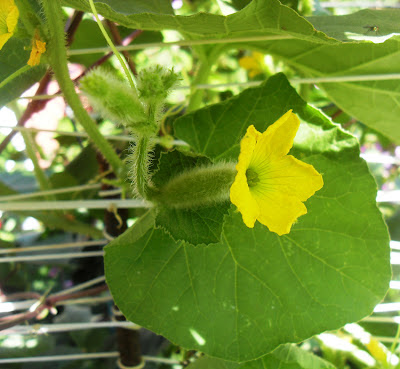My initial encounter with the Purple Hyacinth Bean (Lablab purpureus) came while doing some research into heat tolerant beans online. Supposedly, Thomas Jefferson happened to have this plant as a flower within his garden. I later read more about this bean variety in the book Perennial Vegetables and decided it was worth a try.
 |
| One of my Purple Hyacinth Bean plants after about 3-4 weeks |
My experience with growing the Purple Hyacinth Bean is that it can be a little difficult to start. Going through the effort of chitting the seed (pre-sprouting it before planting it in the soil) is well worth the effort and results in an improved plant emergence rate than putting dry seeds in the soil. When planted in the spring (highs in the 80s and lows in the 60s) the plant grows slowly.
 |
| The Purple Hyacinth Bean Blossom is pink or purple |
Another thing I have noticed about these beans is that they are extremely heat resistant (with local temperatures exceeding 107 degrees Fahrenheit). The Hyacinth Bean requires an average amount of water and doesn’t experience much pest problem though insects will occasionally chew a little on the leaves. I have my beans trellised over a metal shed – something I would never do with cucumbers or Chinese long beans. This occasionally causes the plant to get a little burnt but generally the plant just keeps growing. I did experience a little bit of bean mosaic earlier in the season but that quickly disappeared after I removed the infected leaves and pulled out my Tepary Beans.
 |
| From the top of my metal shed temperatures exceed 107 F |
The pink flowers of the Purple Hyacinth Bean have not attracted near as many insects as I initially thought they would, though bees and butterflies occasionally visit.
|
|
| Purple Hyacinth Bean Pods developing on the vine |
 |
| The Purple Hyacinth Bean plant can produce quite a lot of beans |
One of the reasons why I enjoy growing these beans is because of the color. The beans beautifully contrast the leaves of the plant, as well as the rest of the garden.
|
|
| A week's worth of hyacinth beans |
|
|
| Purple Hyacinth Bean Pods are almost ready to cook. |
How a vegetable tastes is one very important question that many books and websites often leave unanswered. Some, including my family members, who are used to the taste of English-type blue lake bush beans would probably not go for Chinese long beans unless cooked a specific way. So, how do Purple Hyacinth Beans taste? I tried them both raw and cooked to find out. I have read in multiple places that the skins of the mature seeds are poisonous so I decided not to even try cooking them. Eaten raw, the young beans are okay. They taste a little like eating some kind of thick leaf. Although the pods unfortunately lose their purple color when they are stir fried the change of color is more than compensated by a dramatic improvement in taste. The closest thing I could relate the taste of the cooked bean pods is to edamame or soybean pods. My children do not hesitate to tell me if they don’t like the taste of our home-grown produce and they asked for seconds of these beans.
 |
| Although the beans change color they taste really good! |
In summary, other than the dry seeds being poisonous, I would highly recommend Purple Hyacinth Beans to anyone with room to trellis a vine with beautiful flowers and pods. The vine is low–maintenance, takes the heat well and the bean pods taste great when cooked. There are apparently many other hyacinth bean cultivars that I hope to be able to grow in the future.
|
|
| A few seeds ready to plant straight from a dried pod. |








































